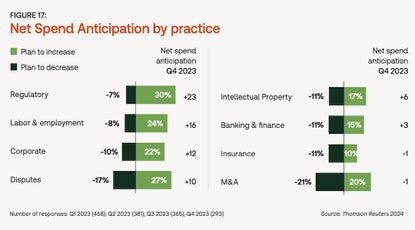Intensifying competition, mergers, and talent acquisition strategies leads to growing disparity in partner billing rates.
The competition among top partners in BigLaw is becoming more intense. This is evident from the growing disparity in the median partner billing rate at firms with more than 750 lawyers compared to those of the next size tier. In 2023, this difference reached a record 61%, the widest it has been in the 11 years that CounselLink has publicly tracked such data.
The Increasing Share of Legal Spend
Law firms with more than 750 lawyers saw their share of legal spend increase to 48.2% in 2023, up from 47.9% in 2022. This growth can be attributed to several factors. One of them is the risk-averse nature of corporate legal departments. They view the potential hazards of switching from a trusted outside counsel as too great, especially given the institutional knowledge firms have built from years of representing a client.
Kris Satkunas, Director of Strategic Consulting at CounselLink, has been advocating for General Counsel to save on legal expenses by looking for rate flexibility down market. However, she acknowledges “if you had good results with a firm for a long time, it would be a risk to change firms.”
The Role of Volume Discounting
A secondary reason why the largest law firms continue to lay claim to nearly half of all legal spend is the use of volume discounting. This incentivizes corporate legal departments to send more work to large firms to reap the benefits of “tiered discounts.”
The Impact of Shedding Low-Rate Practices
Another explanation for BigLaw’s growing share of legal spend and continuing rate increases is the shedding of low-rate practices. This pushes up the average rates of partners at the largest firms. Consultant Tim Corcoran, based on his own work with BigLaw, notes that “Big Law is narrowing the scope of their practice area focus.”
Mergers and Acquisitions
In a significant development, Troutman Pepper Hamilton Sanders and Locke Lord are discussing a merger that would place the combined firm among the 30 largest by revenue. The merger would create a firm of more than 1,600 lawyers and revenue of more than $1.5 billion. This move is seen as a strategic step to boost the operation’s ability to compete with large rivals.
“The larger mergers tend to have a ripple effect on the market,” said Howard Cohl, a Partner at legal recruiting firm Major Lindsey & Africa. “Merger conversations are continually taking place.”
Troutman and Locke Lord did not provide any further comments on the merger. “Our first priority is delivering exceptional legal services to our clients,” they said in their statement.
Talent Acquisition and On-Campus Recruiting
In a shift from traditional practices, top law firms are now rushing to recruit new talent, often before students have even finished their first year of law school. This change has seen on-campus interviews, which were once the primary recruiting method for major firms, take a back seat to direct hiring.
The coveted Summer Associate roles, which serve as a tryout for full-time positions after graduation, are now being filled through this direct hiring process. Nicole Wanzer, Director of Attorney Recruiting at Morrison Foerster, stated that this new process will likely be filling about 50% of their class.
On-campus interviews have been a mainstay of law firm recruitment for decades. However, the loosening of guidelines by the National Association for Law Placement (NALP) in 2018 and the shift to virtual interviews during the coronavirus pandemic have led to firms shifting their recruiting to their own online platforms. Nearly half (47%) of law firms’ summer program hires last year came outside of OCI recruiting, according to NALP.
Signs of a Downward Movement
The report also suggests there may be early signs of a movement down market in certain practice areas, like M&A, litigation, and commercial and contracts, based on the share of legal department spending on new matters.
In 2022, large firms’ 55.3% share of new litigation work decreased to a 44.8% share and their share of new M&A work dipped from 75% to 69.5%. The report notes the largest firms have gained back some of this ground but not all. Overall, large firms’ share of the spending on new matters, which occupy about 30% of legal budgets, has declined from 52.4% in 2021 to 48.7% in 2023.
The Role of Associate Salaries
While Partner rate increases seem high, they’ve been exceeded by rate increases at the Associate level in 2023; on average, Associate rate increases at the largest firms were 11.5% while Partner rate increases were 7.9%. This is due to salary increases for associates in BigLaw, which now approach a $250,000 for 1st-years when factoring in bonuses.
The Prevalence of Alternative Fee Arrangements
While the overall use of alternative fee arrangements remains low at 9.9% of all matters, the report indicates AFAs were most commonly used in IP and labor and employment practices. This is perhaps because those practice areas tend to see higher volumes of commoditized and routine matters than other practices.
The competition among top partners in BigLaw is heating up, driven by a variety of factors. These include the growing share of legal spend, the role of volume discounting, the impact of shedding low-rate practices, and the role of associate salaries. However, there are also signs of a potential downward movement in the market, which could lead to significant changes in the future.










